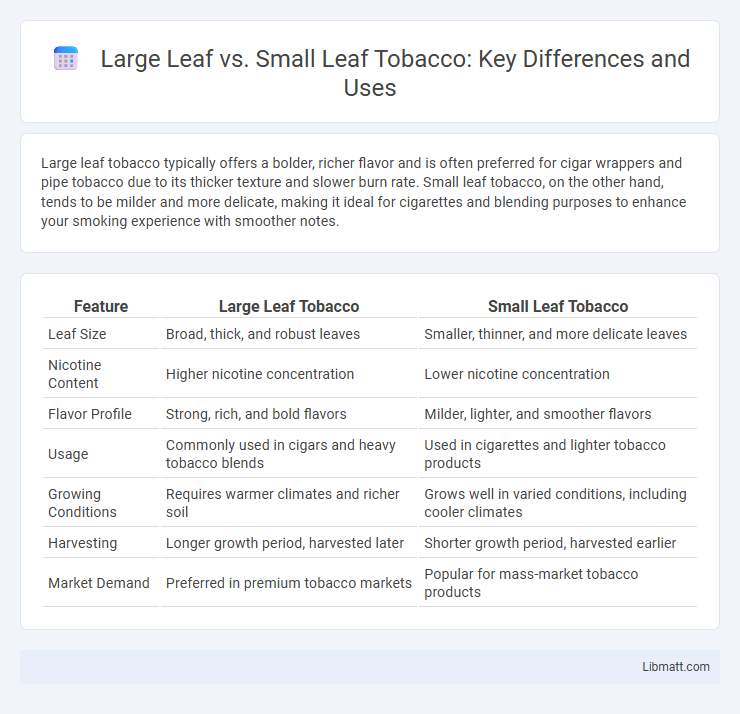Large leaf tobacco typically offers a bolder, richer flavor and is often preferred for cigar wrappers and pipe tobacco due to its thicker texture and slower burn rate. Small leaf tobacco, on the other hand, tends to be milder and more delicate, making it ideal for cigarettes and blending purposes to enhance your smoking experience with smoother notes.
Table of Comparison
| Feature | Large Leaf Tobacco | Small Leaf Tobacco |
|---|---|---|
| Leaf Size | Broad, thick, and robust leaves | Smaller, thinner, and more delicate leaves |
| Nicotine Content | Higher nicotine concentration | Lower nicotine concentration |
| Flavor Profile | Strong, rich, and bold flavors | Milder, lighter, and smoother flavors |
| Usage | Commonly used in cigars and heavy tobacco blends | Used in cigarettes and lighter tobacco products |
| Growing Conditions | Requires warmer climates and richer soil | Grows well in varied conditions, including cooler climates |
| Harvesting | Longer growth period, harvested later | Shorter growth period, harvested earlier |
| Market Demand | Preferred in premium tobacco markets | Popular for mass-market tobacco products |
Introduction to Tobacco Leaf Varieties
Large leaf tobacco varieties generally produce thicker, broader leaves that offer a richer, more robust flavor profile favored in premium cigars and pipe tobacco. Small leaf tobacco, often from varietals like Burley or Virginia, grows faster and provides a milder, lighter smoke ideal for cigarettes and blends. Understanding these differences helps you select the right tobacco leaf based on flavor intensity, burn rate, and intended use.
Defining Large Leaf and Small Leaf Tobacco
Large leaf tobacco refers to varieties characterized by broad, thick leaves predominantly used for cigar wrapper leaves due to their durability and rich flavor profile. Small leaf tobacco, often lighter and thinner, is primarily cultivated for cigarette production and prized for its mild aroma and quicker curing process. These classifications influence cultivation techniques, curing methods, and end-product quality within the tobacco industry.
Key Differences in Leaf Structure
Large leaf tobacco features broader, thicker leaves with a higher chlorophyll content, contributing to a richer flavor and slower burning characteristics. Small leaf tobacco consists of narrower, thinner leaves with less chlorophyll, resulting in a milder taste and faster combustion. The cellular density and vein patterns also differ, affecting moisture retention and leaf flexibility during curing and processing.
Growing Conditions for Large vs Small Leaf Tobacco
Large leaf tobacco thrives in warm, humid climates with rich, well-drained soil that supports its extensive nutrient demands and longer growing season. Small leaf tobacco prefers cooler temperatures and can tolerate less fertile, rockier soils, making it suitable for regions with shorter growing periods. Your choice between large and small leaf tobacco should consider these environmental factors to optimize crop yield and quality.
Curing and Processing Methods
Large leaf tobacco undergoes air curing, hanging in well-ventilated barns for 4-8 weeks, which enhances its mild flavor and retains high sugar content ideal for cigars. Small leaf tobacco typically uses flue-curing, where leaves are exposed to controlled heat without smoke for about a week, resulting in a sweeter, lighter tobacco commonly used in cigarettes. Both curing methods influence the chemical composition and final taste, with large leaf tobacco requiring longer aging to develop complex aromas.
Flavor Profiles and Aroma Distinctions
Large leaf tobacco typically delivers a robust, earthy flavor with deep, rich undertones, often producing a smoky and spicy aroma that highlights its full-bodied character. In contrast, small leaf tobacco tends to offer a milder, sweeter flavor profile with subtle floral and fruity notes, accompanied by a lighter, more delicate aroma that appeals to smokers preferring gentle sensory experiences. These distinct flavor profiles and aroma distinctions influence their respective uses in cigar blends, with large leaf favored for strength and complexity and small leaf chosen for smoothness and aromatic refinement.
Usage in Cigars, Cigarettes, and Other Products
Large leaf tobacco, commonly used in premium cigars, provides a robust flavor and slower burn, making it ideal for hand-rolled cigars and wrapper leaves. Small leaf tobacco, often found in cigarettes and pipe tobacco, offers a milder taste and faster combustion suitable for mass production and blending. Other tobacco products such as chewing tobacco and snuff typically favor small leaf varieties due to their texture and ease of processing.
Yield and Economic Considerations
Large leaf tobacco generally produces higher yields per acre compared to small leaf varieties, making it more economically advantageous for bulk production. Small leaf tobacco often commands premium prices due to its specialty use in cigar wrappers, balancing out its lower yield with greater profit margins. Your choice between the two should consider both the expected yield and market demand to optimize overall profitability.
Disease Resistance and Crop Management
Large leaf tobacco generally exhibits stronger resistance to diseases such as black shank and blue mold due to its thicker leaf structure and genetic traits. Small leaf tobacco requires more intensive crop management practices, including frequent fungicide applications and stricter environmental controls, to mitigate susceptibility to foliar diseases. Effective disease resistance in large leaf varieties can reduce chemical inputs and lower overall production costs compared to the more vulnerable small leaf types.
Choosing the Right Tobacco Leaf for Your Needs
Large leaf tobacco offers bold flavors and higher nicotine content, making it ideal for robust blends or cigars, while small leaf tobacco provides a milder, smoother smoking experience suitable for cigarettes and light blends. Consider your preference for strength and flavor intensity when choosing between large leaf or small leaf varieties, as each type impacts the aroma and burn characteristics. Your choice should align with the desired smoking style and the specific tobacco product you plan to create or enjoy.
Large leaf vs small leaf tobacco Infographic

 libmatt.com
libmatt.com